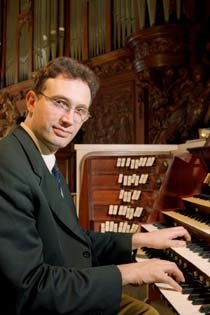 Sunday evening French organist Thierry Escaich offered a lifting celebrity organ recital for the Octave Day of Easter at the Basilica of the National Shrine of the Immaculate Conception. The first half of the program consisted of French and German Romantic music, including an improvisation in Romantic style on a submitted theme. The second half showed Escaich’s skills as a composer and performer of 20th-century and contemporary French music.
Sunday evening French organist Thierry Escaich offered a lifting celebrity organ recital for the Octave Day of Easter at the Basilica of the National Shrine of the Immaculate Conception. The first half of the program consisted of French and German Romantic music, including an improvisation in Romantic style on a submitted theme. The second half showed Escaich’s skills as a composer and performer of 20th-century and contemporary French music.The concert began with a compelling rendition of the Te Deum by French composer Charles Tournemire (1870-1939). Opening loudly with the chant tune in unison, Escaich did an excellent job adapting to the Shrine’s vast acoustic, where toward the end every note could be heard in the brisk passage work on full organ. Unfortunately this clarity and strength were lacking in the German Romantic selections of Brahms (two chorales and the Prelude and Fugue in G Minor) and two movements from the Sonata No. 1 of Mendelssohn. Escaich’s quick tempi were often too much for the room, while clarity was further limited by muddy registrations that were at times overly contrasting – especially in the Brahms chorales.
His Improvisation of a Prelude and Fugue in Romantic Style on a Submitted Theme opened in an impressive Elgar-like mode. As the prelude went on, Escaich continued to add an abundance of material, which left the form of the movement something of a mystery. The clever segue to the fugue was with the soft, deep bass notes of the pedal, above which the fugue subject was stated with the beautiful flutes of the Shrine organ. Given that generally a fugue must either come to an abrupt cadence or literally fall apart into something less resembling a fugue, Escaich continued in an astoundingly strict, formal way and then allowed his fugue to digress into something that could best be described as perpetually faster and louder, followed by a few crashes on the deafening high-pressure trumpet.
The high point of the program was the Joie et Clarté des Corps Glorieux of Messiaen. For possibly Messiaen’s most overtly enthusiastic work for organ, Escaich confidently presented the excited angular trumpet melody with gusto. At the end of the work, the glorious trumpet melody sounded as if it literally shot up into the heavens. Escaich’s own III Poèmes pour Orgue, with incredible rhythmic syncopations, sounded much like his improvisations and were played with much more stability. The World Awaiting the Savior of Marcel Dupré (1886-1971), a movement from his Symphonie Passion, was very well played and portrayed the struggle, chaos, and commotion of a world in need of a savior. The gentle and redemptive melodic material later in the movement was very moving. His Free Improvisation on Submitted Themes was something of a confusing romp with the previously used and somewhat superficial form of faster, louder, and then some high-pressure reed crashes. The second given theme was the Gregorian Alleluia – often used in Catholic services and at the earlier Mass that day at the Shrine – that was incorporated bit by bit rhythmically, motivically, and then fully.
No comments:
Post a Comment